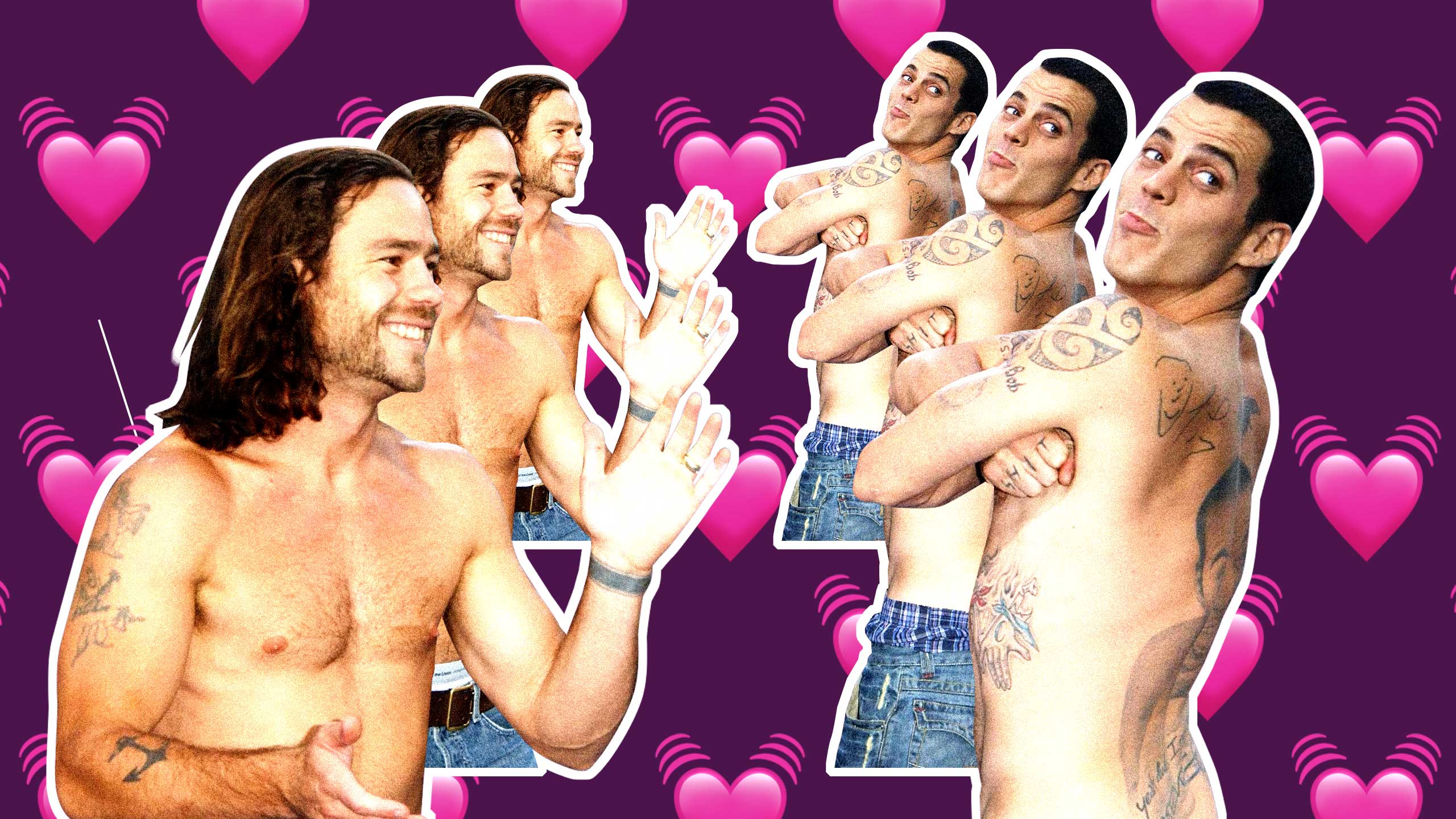The movie opens on a city street filled with people going about their daily routines. Suddenly, the peace is destroyed. Cars and buildings are crushed and set aflame by a 100-foot-tall green monster that looks suspiciously like Chris Pontius’ cock and balls smeared in green paint. I’m watching Jackass Forever, and all of a sudden I’m 12 years old again.
Jackass Forever marks the fourth feature film in the Jackass franchise, which I have always adored. It perfectly slots into a niche of comedy that we all crave, even if we don’t want to admit it: seeing people hurt themselves in ridiculous ways. What started as a low-budget MTV show with pranks like annoying golfers by blaring air horns from the bushes (objectively hilarious) has evolved into a global phenomenon, launching breakout star Johnny Knoxville and the rest of the gang to celebrity status and spurring various spinoff shows and movies.
While one might initially assume that a show about bunch of straight cis white dudes electrocuting each other and hitting each other in the balls would be aimed at fellow straight cis white dudes, Jackass seems to have achieved the unachievable: universal appeal. It turns out there is no gatekeeping when it comes to being launched into the air in a porta potty filled with dog shit. Its accessibility has attracted hoards of queer and trans fans, who see themselves in the ridiculousness of the guys and appreciate the lack of rigid gendering of the content. Hurting yourself in silly ways is possible and hilarious no matter your gender or sexual identity, and in Jackass, laughter is never aimed at someone because of who they are, rather how they react to whatever ridiculous prank is being pulled.
Jackass showcases a certain kind of positive masculinity despite being reared in the early aughts, when comedy was dominated by “no homo bro” sentiments (you couldn’t get through an episode of Friends without a landslide of gay jokes). The Jackass guys are comfortable with each other’s bodies, even guiding their co-star’s dicks into various positions to be bitten by snakes and other horrors. One might venture to say it’s homoerotic in a way that doesn’t mock being gay, which was surprisingly ahead of its time (Saturday Night Live was still casually using the word “dyke” in skits around the same time). The segments show dudes just genuinely caring about each other, which was even less common: they always help each other up off the ground, regardless of who knocked them over in the first place.
Body language expert and author Jess Ponce III says there’s a lasting appeal of the male friendships shown in Jackass, even 20 years on.
“First off, the idea of male friendships being homoerotic is an outdated concept,” he says. “Unless they are intended to showcase homoeroticism, male friendship can be close and even physical without too much questioning. Our ideas of what it means to be a ‘man’ have evolved over the past 20 years.”
“This said, the connection and close friendships found in the original Jackass dared to push its contemporary concept of male bonding,” he adds. “They were connected on a deeper level than just ‘bros.’ They were ‘ride or die’ friends—[they were] different in that approach than we had seen on TV previously.”
Jackass is representative of how guys actually behave around each other when they’re just messing around. They’re violent in the same way you see between siblings: no holds barred, yet followed by deep consideration when someone actually gets hurt or scared. The boys are allowed to feel a spectrum of emotions, from pain to fear to absolute elation when something goes according to plan. In our society, that’s not a universal thing.
JB, a trans-masc non-binary musician from Providence, Rhode Island, grew up seeking approval and acceptance from guys. They say they find it really sweet and comforting to see men—like those in Jackass—embrace their softness and genuinely care for each other in their friendships.
“Something about it feels safe. Through the chaos and sheer masochism, there’s just so much love and openness that shines through,” they say. “I love that they can make fun of and totally deconstruct their masculinity with each other and embrace their love for each other without fear of seeming gay. Kind of makes it seem like their lack of care toward that narrative means there’s less homophobia, at least being expressed externally.”
JB finds the casual and easy way the Jackass guys present their masculinity in their friendships and camaraderie is especially accessible to queer folks.
“It doesn’t necessarily feel homoerotic to me, but it’s almost like the way they express their masculinity is in a way where they take it less seriously. When masculinity feels more accessible and lower stakes, it feels welcoming and aligns more with how I wish it felt in my own experience,” they say.
Izzy, a bisexual, queer psychology student from Montreal who has been watching Jackass since the early 2010s, also feels that the show was ahead of its time. For her, its humour was never edgy or about taking a stab at other peoples race or identity—instead, the guys always focused on each other in the moment.
“It definitely felt like they were very supportive and brotherly with each other and their only focus was to have fun, get back at each other and take care of each other when needed,” she says. “I think it feels ‘safe’ in that way to watch because everything is all in good fun without putting women and queer people down which you often saw in media, especially back then.”
Jackass, from TV to film to YouTube, was very formative to my generation’s sense of humour: my own school friends attempted their own Jackass-style series where they filled a motorcycle helmet with packing peanuts and shoved it onto their heads (teenage boys??) or stapled their hands. The positive, non-judgmental masculinity of Jackass has also become a bonding point for queer folks—a safe and ridiculous haven from any aggressively gendered messages.
“I also love that I have some other close trans friends who love Jackass,” says JB. “Masculinity in its standard toxic state can be so scary, especially with how it can manifest in violence toward gay and trans people. But when it’s taken so lightly and positively, it feels safe to engage in. I love being in spaces where I can just embrace being goofy, and that can be hard to do with men without feeling like any of it is at my expense.”
Of course, the original Jackass crew was entirely white dudes, which left a little bit to be desired when it came to diversity. In Jackass Forever, however, the cast has been extended to include Rachel Wolfson (a woman!). It also includes Jasper Dolphin, Compston “Darkshark” Wilson and Eric Manaka, all of whom are Black, and Zach Holmes, who has a rainbow cock and balls tattooed on his stomach (whether or not that’s a coming out, it’s about as gay as a tattoo can get). This updated crew only further serves the all-encompassing appeal of the movies: nobody is ever mocked for who they are, just how much they scream when they get stung by a scorpion.
“Even though there have been no women involved, really, until Rachel, nothing that I’ve seen them do has been at the expense of women’s comfort or safety either,” says JB. “So even if they’ve lacked direct inclusivity, they maintain a baseline level of respect which media like Jackass could so easily and expectedly disregard. They seem, in many capacities, to be guys of a quietly strong moral grounding and that keeps it lighter and sweet.”
This lightness is part of the appeal for everyone, but its a particular draw for queer people because it shows a world where men are a threat only to themselves and their friends. These are the guys who would never push you over for who you are because they’re too busy sticking leeches on each other and screaming with laughter. Positive masculinity shines through in Jackass; you might not get a group of cis women doing the same shit you see Steve-O doing, but there is nothing toxic or harmful about this specifically guy-only behaviour. They’re just dudes being dudes.
Here’s to the Jackass crew and their bruised, battered bodies. Long may they create a world where anyone can enjoy the peak of comedy: dudes getting hit in the balls.


 Why you can trust Xtra
Why you can trust Xtra


